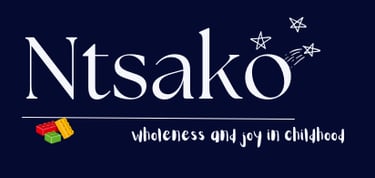
What's what in the Brain? : Basic Structures and Functions
2.1. An overview of some of the main sections of the human brain with some helpful diagrams to increase understanding
ISSUE 2
VJ Tlakula
5/14/20257 min read


The Brain - A Basic Overview
Learning about the brain and how it works is one of the most fascinating things to me. I always imagine that understanding how someone’s brain works, together with their history and context is a fantastic way of getting to know and understand them. I believe it’s important for us to begin to discuss the brain of the child because it is a constantly developing organ from very early after conception. So, when something may go wrong, it is important to understand how and why, and its implications for the child. Remember from Issue 1 that the experiences of the environment the child is in can seriously affect their biological development in both good and bad ways. As my first-year psychology textbook states: in many ways it is your brain that makes you who you are. This is why we study the brain as we study the young child, because how it develops is crucial.
Understanding a bit about how the brain functions is also a very good launching point for the rest of our Blog Series, which will take us physically into the brain and show us different elements of how the child’s stages of physical brain development play out in their lives. It also shows why we in Developmental Science understand things the way we do and then ask people to respond this knowledge the way we do.
Later parts of this Issue will discuss specifically how the baby's brain develops and works. For now, we take a very basic look into a fully grown, typical human brain.
Let's get into it
It’s time for a short biology lesson. (Images provided below to help you imagine it).
The brain, even though it is a relatively small organ, is extremely complex and constantly controls the entire body. It is not just a single thing where it’s all a confused and jumbled mess, or where we only use some of our brains. Rather, like every other organ, it is an extremely organised structure with many different sections all responsible for different jobs. These sections constantly communicate with each other and work together. Because it is so complex, it is also a huge amount of tissue that needs to fit into a small space. This is one reason it has the many folds that give it its "wavy" look and texture.
The brain is possibly one of the most physically protected organs in the body. In addition to a thick skull, it is covered by 3 protective layers of tissue, called meninges, and cerebrospinal fluid (CSF), a liquid surrounding the brain which nourishes and cushions it from shocks like banging your head. CSF is also carried around and within the brain through things called ventricles, helping it to function well.
The brain, together with the spinal cord, forms the central nervous system, but there are many other “systems” in the body, all in charge of us going about our lives and the physical functioning of the body. However, the brain, in many ways, directs the functioning of these systems.
The brain, with its many sections, functions through sending and receiving billions of electrochemical signals at lightning speed through tiny cells called neurons. These signals are called neurotransmitters, and they all have different shapes and sizes designed to send specific types of messages. Neurons and the signals they send are extremely important because they are involved in how the brain literally learns, physically grows, and responds to the environment.
There are many parts of the brain which are all extremely important to its functioning and our understanding of it. But for now, I want to focus on the 3 main sections - the hindbrain, the midbrain, and the forebrain. This is as these are the functional bits that communicate with each other and the rest of the body. This is where it gets fun.
The Hindbrain and Midbrain
The hindbrain is deepest in the brain, connecting it to the spinal cord. This section is where everything we need to live/survive is. In this we have the medulla oblongata, pons and cerebellum. The medulla oblongata is responsible for breathing, circulation, heart functions, and all involuntary behaviours. If this is damaged, a person dies. The pons is the message station that sends signals (information) back and forth between the spinal cord and the brain (remember the spinal cord has all sorts of nerves that help the body to send messages and move and function). Basically, it helps the brain communicate with the rest of the body. The cerebellum is involved in all movement, posture and balance (and also some kinds of learning).
Sitting above the hindbrain is the midbrain. This is made of the reticular formation. The reticular formation starts in the hindbrain but goes into the midbrain too. It is a structure made of millions of neurons that connect to all the areas of the brain. It is responsible for arousal (not sexual arousal, but the brain’s state of readiness for activity/action) and sleep/wake consciousness. So, if this gets damaged, this is where a person gets into permanent sleep or a coma even though they are still alive.
The Forebrain
The last, section is the forebrain. The forebrain is made up of 5 main sections, and is the largest part of the brain. In here is the thalamus, hypothalamus, limbic system, basal ganglia, and cerebrum.
The thalamus is the first structure involved in processing any sensory information from the outside world. It then decides where to send this information in the brain (assigns them to the appropriate brain part), and some information it emphasises over others if it seems more important. Almost like the receptionist at the hospital when you come with a problem, they decide where to send you based on what is it and how urgent your problem is compared to other patients.
The hypothalamus is in charge of emotions, sleep-wake rhythm, sexual activity, temperature regulation, hunger and thirst. It also controls something called the pituitary gland, which is a gland in charge of all the other glands (organs producing substances affecting bodily functions). It regulates growth, and metabolism. So, the hypothalamus’ job is vital, linking the nervous system to the endocrine (hormone and gland) system.
Next is the limbic system. In the limbic system we have the hippocampus and amygdala (sections we will likely discuss a lot more in future pieces). The hippocampus is involved in certain kinds of memory. The amygdala is involved in learning, experiencing emotions, remembering emotional events, and recognising fear in other people. When we speak of psychological child development, especially in stress, we pay a lot of attention to the amygdala.
The basal ganglia is not a structure so much as a network of other systems involved in movement, memory, and mood, and is also part of the limbic system.
The last bit of the forebrain is the cerebrum (cortex). This is the bit that most people are very familiar with when they look at pictures of the brain. It is the outer layer of the cerebrum and actually is the bit that is easiest for us to study what’s going on through brain scanning (because it is the closest part to the skull). The other parts of the cerebrum are called ‘subcortical’ and are a bit harder to study just because of how deep they are in the brain.
The cerebrum is the last section to fully develop and it has four main sections (called lobes). Each lobe has a left hemisphere version and a right hemisphere version. These are the frontal lobes, occipital lobes, parietal lobes, and temporal lobes.
The occipital lobes are responsible for everything to do with vision and understanding visual information. The temporal lobes are concerned with everything to do with language and hearing, and some visual association. The parietal lobes deal with making meaning from sensory experiences, sense of touch, detecting movement, locating things in space, and being able to perceive your body in space (knowing where and how your limbs are in relation to the world around you). The frontal lobes are where all human activity and cognitive functions occur. They have everything to do with planning, organising, abstract thinking, coordination of voluntary movement, complex thought and problem-solving, appropriate social functioning, and behaviour.
Association Areas
Now we have the basics of the brain itself sorted, there are all sorts of moving parts within the brain and body. Even within these main sections, there are multiple sub-sections. In particular, when we’re learning about development, something called primary and association areas become important. Remember our thalamus in the forebrain? Once it has decided where the information should go, it sends that information to one of the relevant four lobes we discussed in our cerebrum (cortex). Each of these lobes has a primary area which immediately receives that information. It then sends the message to the association area which is responsible for making meaning of the message for the rest of the brain/body. Once the brain has made meaning of this signal, it can then instruct itself and the rest of the body to respond to the stimulus appropriately.
Conclusion
This has been the overview of the human brain and its basic structures and functions. While we will build on the brain more in later pieces, it is good to have a basic understanding of the different sections of the brain and how they function. Developmental Scientists and many other professionals who study child development look far beyond this basic brain and use specialised equipment to figure out how the brain is working and how different areas communicate. They also study the many other parts of the body which are working together with the brain.
In the next parts of this Issue, we explore how the brain develops from pregnancy, how we can then understand the young child's brain to be working, and, lastly, some of the environmental effects on the brain, touching lightly on genetics. Stay tuned!
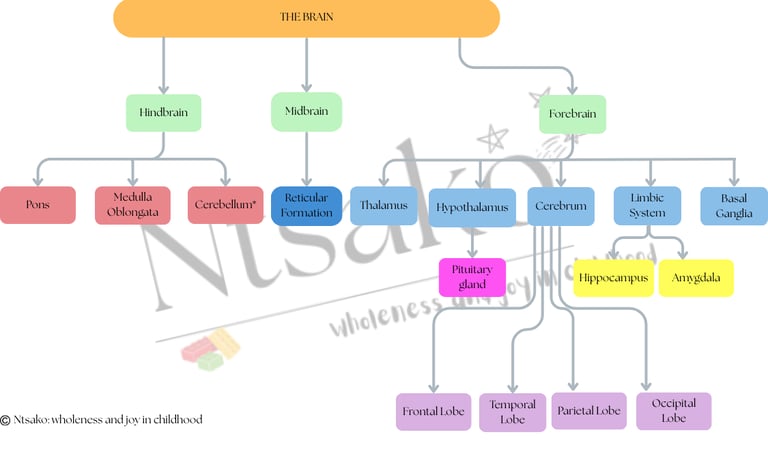

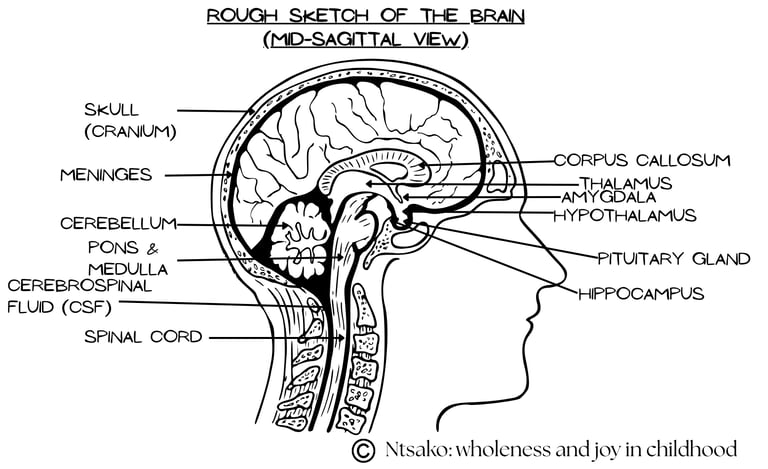


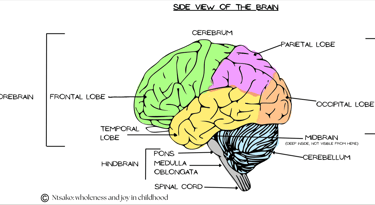
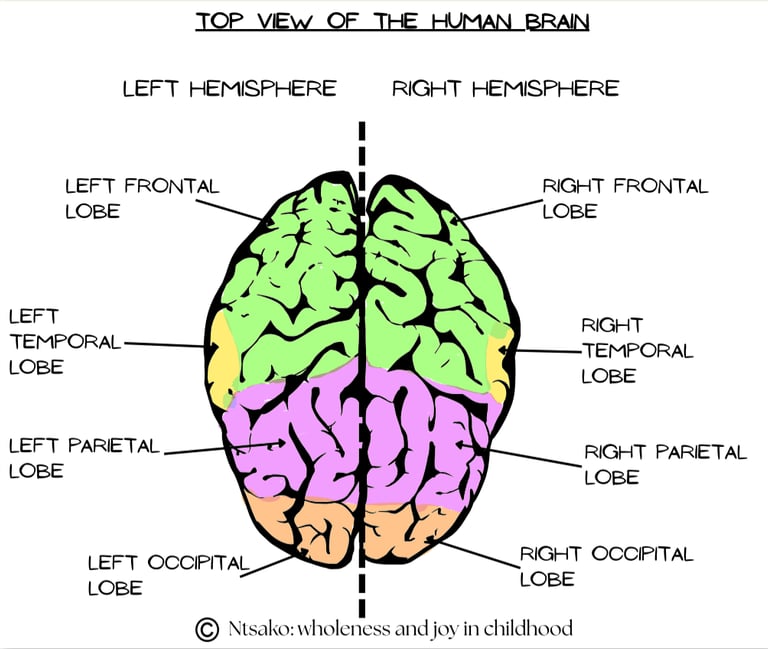

Share your Comments Below!
Please feel free to reach out with any comments, questions, and child-related stories
Celebrating childhood and development
© Ntsako Wholeness and Joy in Childhood 2025. All rights reserved.
Copyright Vutlhari Joy Tlakula 2025. All Rights Reserved.
